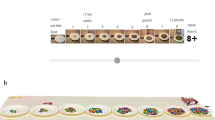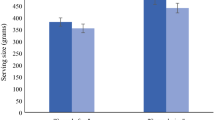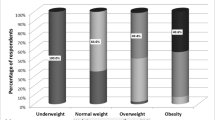Abstract
Background:
Portion size is an important component of dietary advice for weight control, but little is known about what portion sizes people consider ‘normal’. This study determined the effect of body mass index (BMI), gender, dietary restraint and liking of the food on personal and social portion size norms for a range of foods and the degree of certainty over the norms.
Methods:
Thirty lean (BMI 20–25 kg m−2) and 30 obese (BMI 30–35 kg m−2) men and women (aged 18–60 years) viewed 17 different portion sizes of 12 foods on a computer screen on two occasions a week apart. Participants responded ‘more’ or ‘less’ to each photograph reflecting personal portion size preference or perceived portion sizes of others. Personal and social norms for portion sizes of each food were determined using the method of constant stimuli giving a sigmoidal curve of the probability of answering ‘less’ over a range of portion sizes. The slope of the sigmoid at the norm gave a measure of certainty about the norm. Regression models were used to examine the effect of BMI, gender, dietary restraint and liking of the food on personal norms, social norms, the relationship between norms, and the slopes.
Results:
Personal norms were significantly larger in the obese (P=0.026), men (P<0.001), those with lower dietary restraint (P<0.001), and those with higher liking for the food (P<0.001). Social norms were larger for women (P=0.012). The slopes at the norms were 30% shallower in the obese and in men (P<0.001).
Conclusion:
Larger personal norms for portion size among the obese, men, those with lower dietary restraint and those with higher liking for a food imply greater consumption, which may undermine weight control. Shallower slopes for norms in the obese and in men may imply less clearly defined habitual portion sizes.
This is a preview of subscription content, access via your institution
Access options
Subscribe to this journal
Receive 12 print issues and online access
$259.00 per year
only $21.58 per issue
Buy this article
- Purchase on Springer Link
- Instant access to full article PDF
Prices may be subject to local taxes which are calculated during checkout




Similar content being viewed by others
References
Lewis HB, Ahern AL, Jebb SA . How much should I eat? A comparison of suggested portion sizes in the UK. Public Health Nutr 2012; 15: 2110–2117.
Colman AM . Oxford Dictionary of Psychology, 3rd edn, Oxford University Press: Oxford, UK, 2009.
Herman CP, Polivy J . Normative influences on food intake. Physiol Behav 2005; 86: 762–772.
Herman CP, Fitzgerald NE, Polivy J . The influence of social norms on hunger ratings and eating. Appetite 2003; 41: 15–20.
Roth DA, Herman CP, Polivy J, Pliner P . Self-presentational conflict in social eating situations: a normative perspective. Appetite 2001; 36: 165–171.
Leone T, Pliner P, Herman CP . Influence of clear versus ambiguous normative information on food intake. Appetite 2007; 49: 58–65.
Croker H, Whitaker KL, Cooke L, Wardle J . Do social norms affect intended food choice? Prevent Med 2009; 49: 190–193.
Robinson E, Benwell H, Higgs S . Food intake norms increase and decrease snack food intake in a remote confederate study. Appetite 2013; 65: 20–24.
Burger KS, Kern M, Coleman KJ . Characteristics of self-selected portion size in young adults. J Am Diet Assoc 2007; 107: 611–618.
Wilkinson LL, Hinton EC, Fay SH, Ferriday D, Rogers PJ, Brunstrom JM . Computer-based assessments of expected satiety predict behavioural measures of portion-size selection and food intake. Appetite 2012; 59: 933–938.
Brunstrom JM, Collingwood J, Rogers PJ . Perceived volume, expected satiation, and the energy content of self-selected meals. Appetite 2010; 55: 25–29.
Brunstrom JM, Rogers PJ . How many calories are on our plate? expected fullness, not liking, determines meal-size selection. Obesity 2009; 17: 1884–1890.
Brunstrom JM, Rogers PJ, Pothos EM, Calitri R, Tapper K . Estimating everyday portion size using a 'method of constant stimuli': in a student sample, portion size is predicted by gender, dietary behaviour, and hunger, but not BMI. Appetite 2008; 51: 296–301.
Brunstrom JM, Shakeshaft NSG . Measuring affective (liking) and non-affective (expected satiety) determinants of portion size and food reward. Appetite 2009; 52: 108–114.
Herman CP, Roth DA, Polivy J . Effects of the presence of others on food intake: a normative interpretation. Psychol Bull 2003; 129: 873–886.
Schwartz J, Byrd-Bredbenner C . Portion distortion: typical portion sizes selected by young adults. J Am Diet Assoc 2006; 106: 1412–1418.
Food Standards Agency Food Portion Sizes, 3rd edn, The Stationary Office: London, UK, 2002.
Nelson M, Atkinson M, Meyer J . Food Portion Sizes: A User's Guide to the Photographic Atlas. MAFF Publications: London, UK, 1997.
Stunkard AJ, Messick S . The three-factor eating questionnaire to measure dietary restraint, disinhibition and hunger. J Psychosom Res 1985; 29: 71–83.
Rangan AM, Schindeler S, Hector DJ, Gill TP . Assessment of typical food portion sizes consumed among Australian adults. Nutr Diet 2009; 66: 227–233.
Kelly MT, Rennie KL, Wallace JMW, Robson PJ, Welch RW, Hannon-Fletcher MP et al. Associations between the portion sizes of food groups consumed and measures of adiposity in the British National Diet and Nutrition Survey. Br J Nutr 2009; 101: 1413–1420.
Prentice AM, Black AE, Coward WA, Davies HL, Goldberg GR, Murgatroyd PR et al. High levels of energy expenditure in obese women. Br Med J 1986; 292: 983–987.
Stice E, Fisher M, Lowe MR . Are dietary restraint scales valid measures of acute dietary restriction? Unobtrusive observational data suggest not. Psychol Assess 2004; 16: 51–59.
Stice E, Cooper JA, Schoeller DA, Tappe K, Lowe MR . Are dietary restraint scales valid measures of moderate- to long-term dietary restriction? Objective biological and behavioral data suggest not. Psychol Assess 2007; 19: 449–458.
Robinson E, Thomas J, Aveyard P, Higgs S . What everyone else is eating: a systematic review and meta-analysis of the effect of informational eating norms on eating behavior. J Acad Nutr Diet 2014; 114: 414–429.
Acknowledgements
SEF, HBL, ALA and SAJ designed and set up the study. HBL, KV, ER and SH conducted the research. HBL analysed data, interpreted results and drafted the manuscript. SEF, ALA, KV, ER, SH and SAJ interpreted results and critically revised the manuscript. We thank all of the volunteers who took part in the study. This study was supported by a program grant from the UK Medical Research Council (U105960389). This study was supported by a programme grant from the UK Medical Research Council (U105960389). The funders had no role in study design, data collection and analysis, decision to publish or preparation of the manuscript.
Author information
Authors and Affiliations
Corresponding author
Ethics declarations
Competing interests
The authors declare no conflict of interest.
Rights and permissions
About this article
Cite this article
Lewis, H., Forwood, S., Ahern, A. et al. Personal and social norms for food portion sizes in lean and obese adults. Int J Obes 39, 1319–1324 (2015). https://doi.org/10.1038/ijo.2015.47
Received:
Revised:
Accepted:
Published:
Issue Date:
DOI: https://doi.org/10.1038/ijo.2015.47
This article is cited by
-
Obesity and Eating Disturbance: the Role of TFEQ Restraint and Disinhibition
Current Obesity Reports (2019)
-
Portion Size: Latest Developments and Interventions
Current Obesity Reports (2017)



